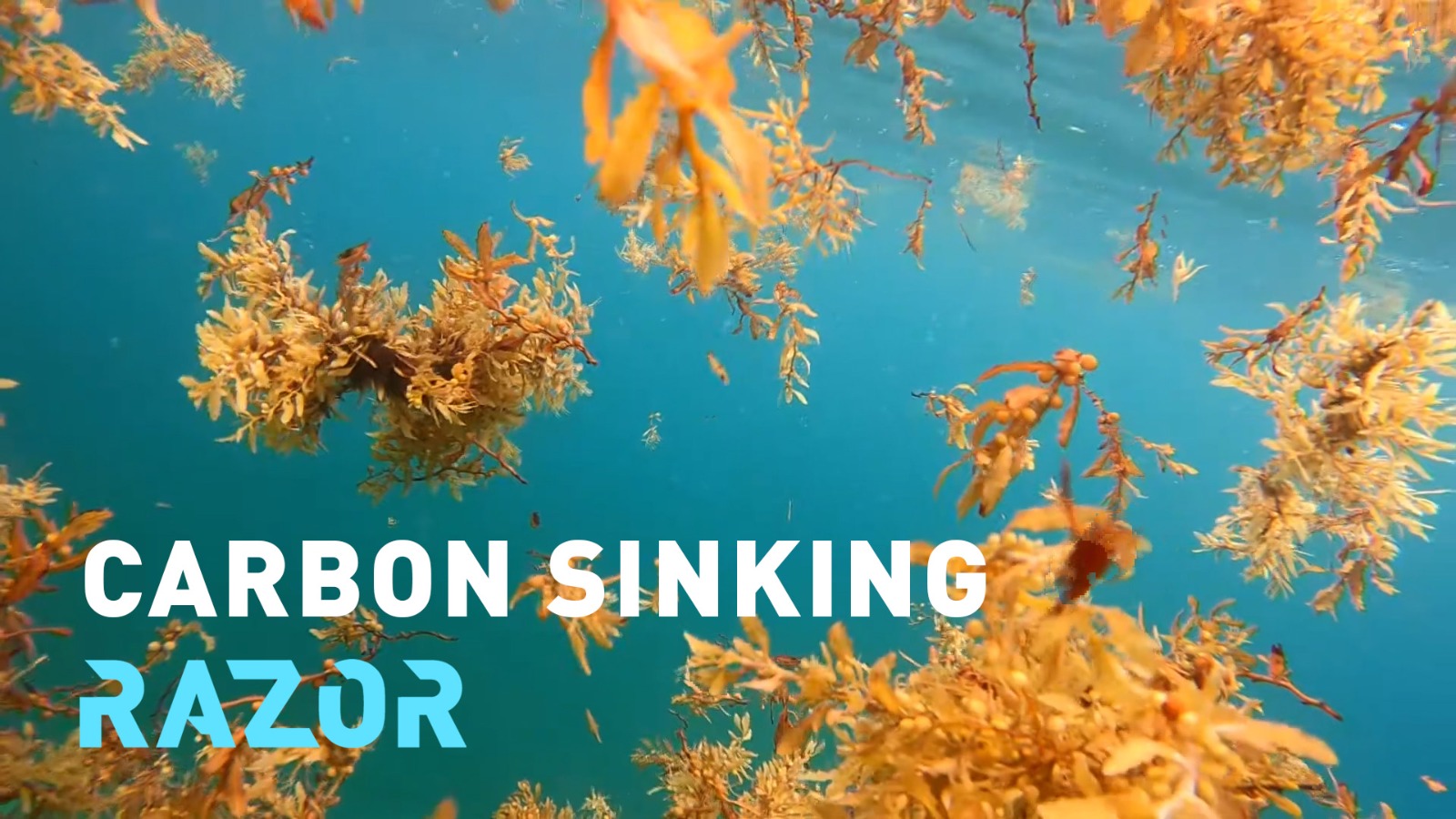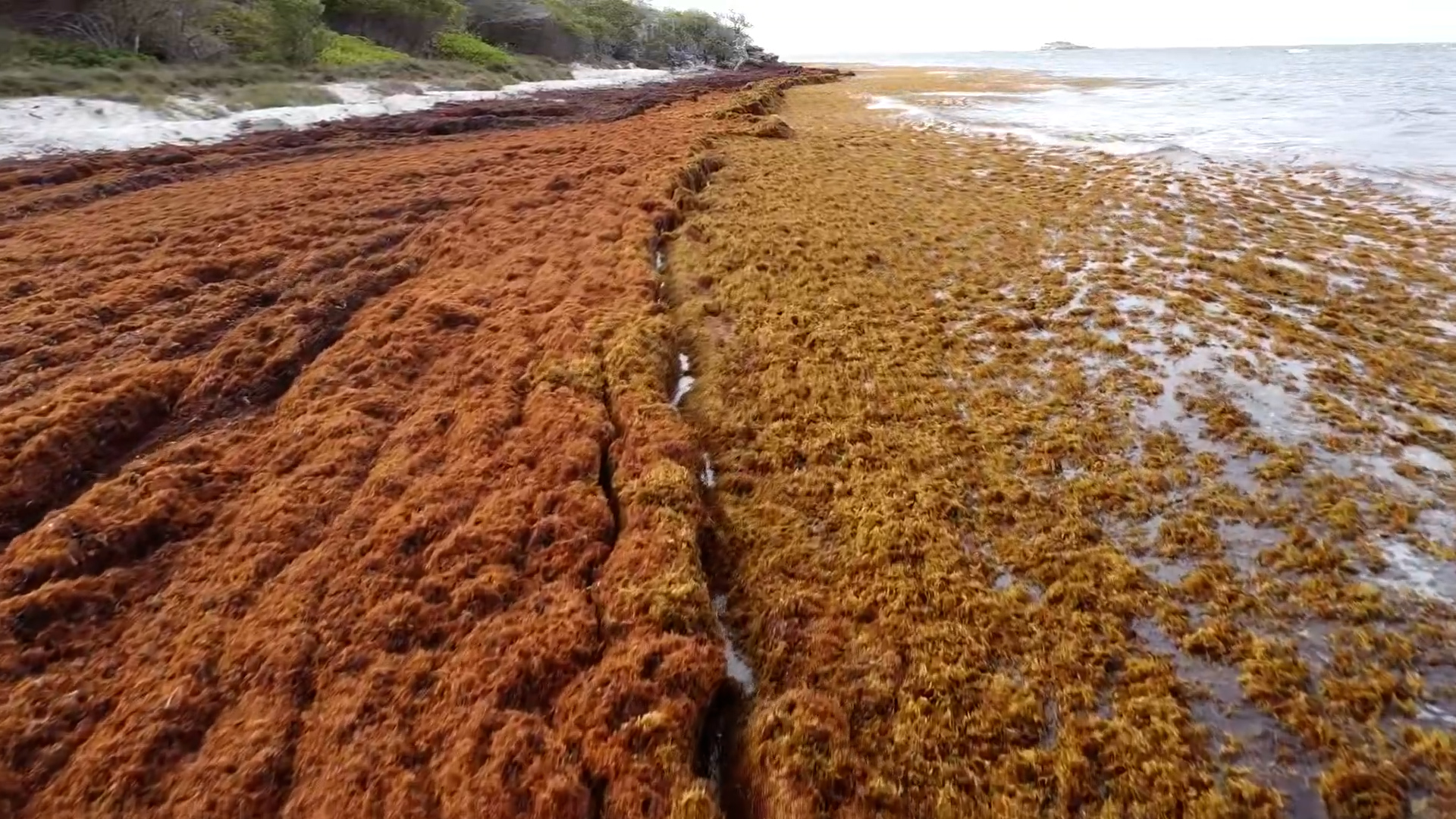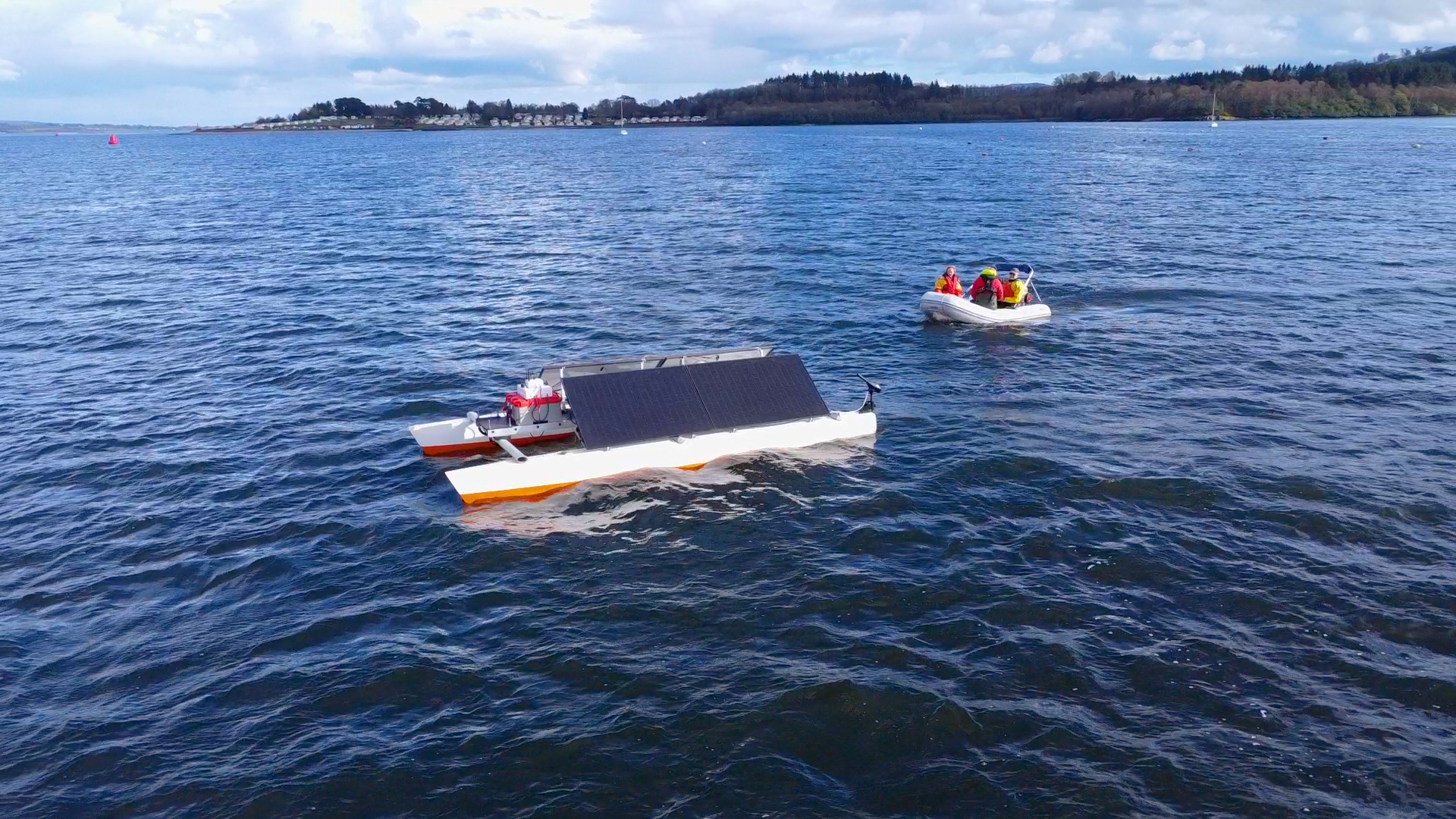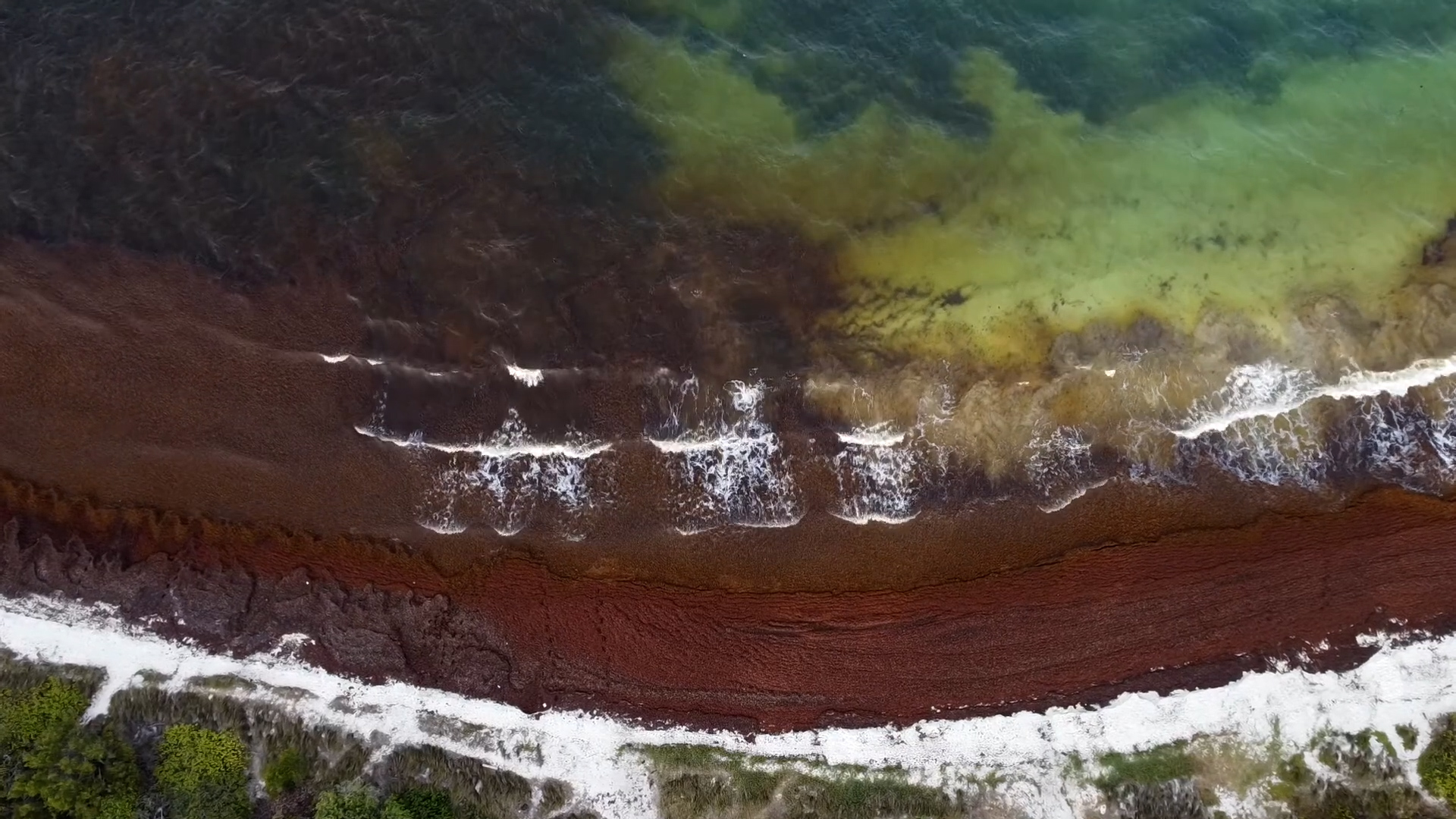30:10

It's sometimes known as the 'floating golden rainforest.'
Large patches of a leafy brown seaweed called sargassum are often seen dotting the ocean surface, occasionally stretching for miles.
But in recent years, huge amounts have been washing up on coastal areas, smothering beaches with a rotting, fetid blob that can be hazardous to people and animals.
Now, a company in Scotland thinks it can help solve the problem by using sargassum to fight climate change.
RAZOR's Neil Cairns went to find out how.

Sargassum piled up on a beach. /CGTN
Sargassum piled up on a beach. /CGTN
A sargassum surge
Sargassum comes from the deep Atlantic, in a vast stretch of ocean called the Sargasso Sea. It's bound not by land but the forces of four major ocean currents.
And it's developed a unique ecosystem, acting as a refuge and breeding ground for birds, fish, eels and turtles.
Unlike other seaweed, sargassum has air sacs that let it float on the ocean surface, where it also reproduces. A large part of the biomass is concentrated in a 5,000-mile stretch called the Great Atlantic Sargassum Belt, which stretches all the way from West Africa to the Gulf of Mexico.
In the last few years, huge amounts of sargassum have been washing onto beaches, including in the Caribbean, Florida, Mexico's Yucatan Peninsula and Ghana.
The cause of the surge hasn't been definitively established, although there are some leading theories.
"It's being swept around by the currents in the central Atlantic region. And as it gets swept towards river deltas, it takes up loads of nutrients that are coming off the rivers and explodes in terms of growth," says Patricia Estridge, CEO of the startup Seaweed Generation.
For places that are heavily dependent on tourism, it can be disruptive and dangerous.
Stretches of the undulating seaweed can entangle fishing boats and water purification systems, as well as people and animals who encounter it. The thick brown algae releases harmful gases and smells like rotten eggs as it decays. This can be deadly to seagrass and baby turtles.
Sargassum also absorbs arsenic, which means it can't be used as food for humans or animals, without intensive processing.
Even composting could introduce arsenic into the water table and compromise drinking water.
But Estridge says her company has a solution that could help keep the beaches clear and also battle climate change.
"All seaweeds photosynthesize as they grow. And that means that they can be really handy for carbon absorption. So we need to absorb a lot of carbon dioxide from the atmosphere, excess carbon dioxide that we've put up there. And what we think we can do is sink the sargassum into the deep ocean and remove that carbon that it contains from the fast carbon cycle," she explains.
And she hopes to do it with a robot.

A prototype of a sargassum-gathering vessel by Seaweed Generation. /CGTN
A prototype of a sargassum-gathering vessel by Seaweed Generation. /CGTN
Sinking hopes
It's slightly tense on the shores of Castle Semple Loch.
Staff from Seaweed Generation are waiting to see if their latest prototype will successfully sail on its maiden voyage.
The semi-autonomous vessel moves forth on the Scottish lake, and smoothly turns on choppy blue waters.
It contains a robot called the AlgaRay, which is designed to scoop up sargassum mats before they come ashore, and sink them in the deep seas for carbon dioxide removal.
The aim is to have a swarm of these vessels in the Caribbean, scooping up sargassum, and the carbon it's captured during photosynthesis, consigning it to the cold, dark depths of the Atlantic.
For that, they will need to be submersible – which the company's head of marine engineering assures us will not be a problem for the solar panels that power the vessels.
"Solar panels can actually be more efficient slightly under the water," says Paul Gray.
"The light refracts in and it enables us to avoid issues with the weather. Even if a hurricane comes in, we can tell the vessel to go underwater, stay safe. Whereas a surface vessel would have to go back to port and hide.”
The sargassum is pulled into a container, which is dropped by a winch when it gets full, to a depth of around 200 meters.
That's where the water pressure crushes the air sacs, making the seaweed lose its buoyancy.
From there, it falls out the bottom and sinks to the ocean floor.
As a semi-autonomous vehicle, the robot will need to be smart and learn fast.
It will be equipped with cameras and sensors that record and feed live data back to the Seaweed Generation staff. The connectivity is aided by the Starlink satellite network, developed by Elon Musk's company SpaceX.
Seaweed Generation needs to ensure it sinks the sargassum properly.
By calculating how much carbon is sunk in the seaweed, the company hopes to sell carbon credits to firms and individuals who want green credentials.
"So companies, mostly, and individuals who are looking to get to net zero, they're stopping emissions as much as they can, but some of the emissions, they won't be able to stop them and for that they will purchase credits," says Estridge.
"So if you wanted to say fly from London to New York, we could offset that in about an hour.”
When sargassum is sunk in shallow waters it's likely to biodegrade and release carbon dioxide or worse, a more potent greenhouse gas – methane.
The AlgaRay is designed to only sink sargassum in extremely deep water.
But could it disrupt ecosystems on the deep ocean floor?
"We're spreading it over a large area so it's not compacted," says Mike Allen, the chief scientific officer at Seaweed Generation.
"We're looking at putting seaweed down there at around ten grams per square meter at most, which is hardly anything. It's like two teaspoons of sugar really. That will get remineralized and the bacteria will degrade it, and it will get sedimented," he says.
It's unclear how long the carbon will stay down. Estimates range from a few decades to hundreds of years.
And in order to sequester enough carbon to stay below even a two-degree rise in temperature, we need to remove billions of tons of carbon annually.
But Allen thinks the deep ocean has huge potential as an untapped carbon sink.
"The ocean surface is like a fast carbon cycle. But in the deep, deep ocean it's slow, steady, it's under pressure, it's dark, it's just cold and a lot slower. So once you put carbon into the air, taking it away and that's what we need to fight the climate crisis," he says.

Aerial view of sargassum on beach. /CGTN
Aerial view of sargassum on beach. /CGTN
READ MORE
Meet the tiny robots that could fix your water pipes
Why has antimatter disappeared from the universe?
How Austria is using AI to protect biodiversity
A sea change?
It's unclear why sargassum has grown so much in recent years.
The Great Atlantic Sargassum Belt is so large that it can be detected from space.
Professor Chuanmin Hu, who runs the Optical Oceanography Lab at the University of Florida, pioneered the use of optics and satellites to study the ocean.
"2011 was the first year that the Caribbean Sea had a lot of Sargassum. But in the past five, seven years it became worse and it became a new normal," he says.
The professor's lab has watched sargassum explode since 2011, peaking at 24.3 million tons last year, stretched across from the Gulf of Mexico to the mouth of the Congo.
And observing it from space can help develop methods to pretend future blooms.
Professor Hu says one driver of the growth could be climate change.
"In 2010, there was a stronger than usual wind and ocean currents to bring sargassum from the Sargasso Sea in the north to the tropic Atlantic in the south. And then they started to grow every year. Some years we have a stronger upwelling to bring nutrients from the bottom of the ocean. We may have more dust deposition events, we may have more river flows to carry more nutrients. So there are different factors," he says
"But overall, as human beings, we should care about this emerging phenomenon.”
